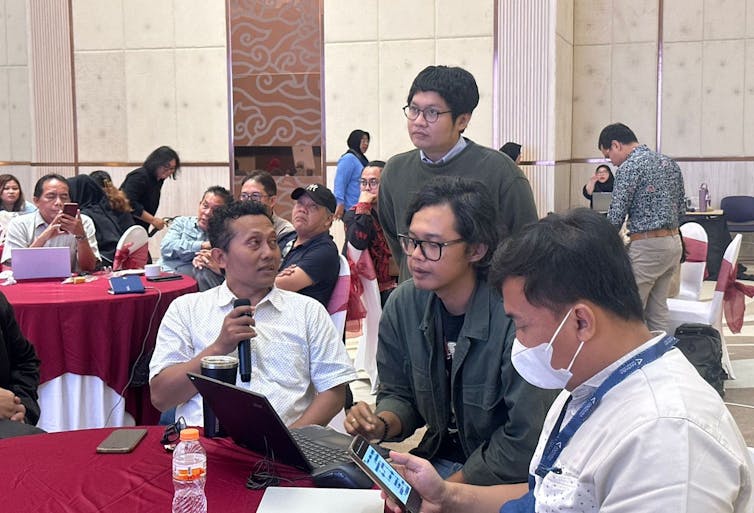More Indonesian children are living with diabetes – so what can we do to prevent it?
- Written by Andini Pramono, PhD Candidate, Department of Health Economics, Wellbeing and Society, National Centre for Epidemiology and Population Health, Australian National University

Indonesian children under 18 were 70 times more likely to be living with diabetes in January 2023 than they were in 2010, the Indonesian Pediatric Society[1] revealed this month.
The Indonesian Pediatric Society said that the childhood diabetes prevalence has increased[2] from 0.028 per 100.00 children in 2010 to 2 per 100.000 children in January 2023. The authors have tried to searched for the original report, but it is not publicly available.
In addition to the Indonesian Pediatric Society data, two other peer-reviewed publications indicate that both type 1[3] and type 2 diabetes[4] are increasing among Indonesian children.
Both types of diabetes are chronic conditions, meaning they are long lasting and can’t be cured. People with diabetes must consistently control their blood sugar to achieve optimal life.
Excess weight is a major risk factor for developing diabetes. It is why controlling diets[5] is vital for preventing overweight, obesity and diabetes.
The 2018 National Health Research report[6] showed that a tenth of Indonesian children between the age of 5 and 12 years old were obese.
As a researcher in infant and young child feeding, and an accredited practising dietitian, we find that encouraging healthy family diets for children from the time they are babies is one way to keep children’s blood sugar levels in check.
Preventing diabetes in children with breastmilk from birth
There are two main types of diabetes: type 1 and type 2 diabetes.
The most typical diabetes diagnosed in children is type 1 diabetes[7]. It happens when the body cannot produce enough of a hormone (insulin) to regulate turning food into energy.
The cause of type 1 diabetes is unclear, though it is often considered genetic. However, many studies[8] have shown breastfeeding reduces the risk of type 1 diabetes[9].
Type 2 diabetes can be diagnosed in children and is preventable. The risk factors of type 2 diabetes[10] are also genetic.
A study has shown[11] the benefit of breastfeeding in preventing the risk of type 1 diabetes for babies[12], as well as avoiding the risk of type 2 diabetes across the lifespan[13].
The first 1000 days of life significantly impact child development[14], including predicting their future diet.
WHO and UNICEF recommend[15] parents initiate breastfeeding immediately after birth for at least 30 minutes, with exclusive breastfeeding from birth until six months old, complementary feeding from 6 months old and to continue breastfeeding until two years old or beyond.
After two years old, a child does not need milk, though breastmilk may still be given because it can help increase a child’s immunity[16].
Avoiding high sugar Growing-Up Milk
Many parents feel that the child’s nutrition is complete with Growing-Up Milk (GUM), sometimes called Toddler Milk. GUM is marketed for children aged between 12 and 36 months old.
However, an Indonesian study[17] has shown that GUM tends to be high in sugar. The average sugar content in GUM in the Indonesian market is 7.3 grams per 100 ml (equal to the sugar in lemonade). The study echoes similar research that identified high sugar content[18] in baby foods in South Africa.
Many GUMs distributed in Indonesia claim health benefits for children. However, the sugar content in them make them inappropriate for a child’s diet.
Instead of GUM, parents should give children from 6 months of age fresh and locally sourced foods. They should be prepared accordingly to the family’s diet.
A wide variety of fruits, vegetables and whole grains should also be given to children. Fruits, vegetables and whole grains are rich in nutrients and are shown to be effective in preventing diabetes[19].
What can the government do?
The government should focus on promoting breastfeeding and providing support[20] because breastfeeding is effective in reducing diabetes risk[21], improves child immunity[22] and brings [economic benefits[23]].
The government should also control the distribution and marketing of breastmilk substitutes[24] and GUM[25], which can be misleading.
So far, the Indonesian government has introduced labelling and marketing standards[26] for Growing-Up Milk, but it could do more by stopping the cross-promotion of infant formula and Growing-Up Milk.
The government should also consider a sugar tax.
The sugar tax aims to reduce sugar consumption by reducing the affordability of buying sugar-based products.
A systematic review[27] has shown the effectiveness of this policy.
However, we suggest combining this policy with other interventions, such as increasing health literacy and opportunities for physical activity, particularly among children.
References
- ^ the Indonesian Pediatric Society (www.kompas.id)
- ^ the childhood diabetes prevalence has increased (www.bbc.com)
- ^ type 1 (www.researchgate.net)
- ^ type 2 diabetes (www.ncbi.nlm.nih.gov)
- ^ controlling diets (www.healthychildren.org)
- ^ The 2018 National Health Research report (labdata.litbang.kemkes.go.id)
- ^ type 1 diabetes (www.healthychildren.org)
- ^ many studies (www.ncbi.nlm.nih.gov)
- ^ breastfeeding reduces the risk of type 1 diabetes (www.diabetesincontrol.com)
- ^ type 2 diabetes (www.healthdirect.gov.au)
- ^ has shown (academic.oup.com)
- ^ the risk of type 1 diabetes for babies (academic.oup.com)
- ^ type 2 diabetes across the lifespan (link.springer.com)
- ^ child development (healthyeatingresearch.org)
- ^ recommend (www.who.int)
- ^ increase a child’s immunity (www.healthychildren.org)
- ^ Indonesian study (onlinelibrary.wiley.com)
- ^ identified high sugar content (journals.co.za)
- ^ be effective in preventing diabetes (www.who.int)
- ^ support (www.hse.ie)
- ^ in reducing diabetes risk (bmcpublichealth.biomedcentral.com)
- ^ child immunity (pubmed.ncbi.nlm.nih.gov)
- ^ economic benefits (pubmed.ncbi.nlm.nih.gov)
- ^ marketing of breastmilk substitutes (www.who.int)
- ^ GUM (www.who.int)
- ^ labelling and marketing standards (hukor.kemkes.go.id)
- ^ A systematic review (link.springer.com)
Authors: Andini Pramono, PhD Candidate, Department of Health Economics, Wellbeing and Society, National Centre for Epidemiology and Population Health, Australian National University





